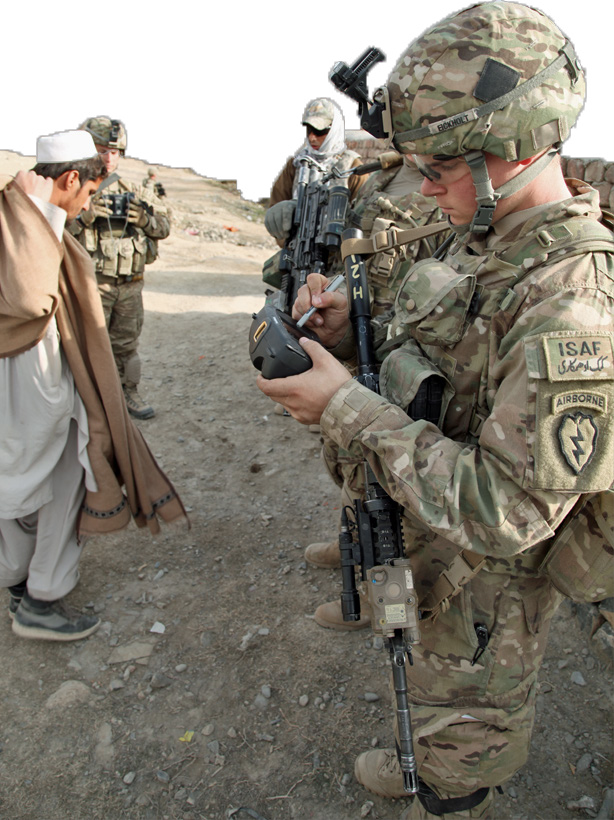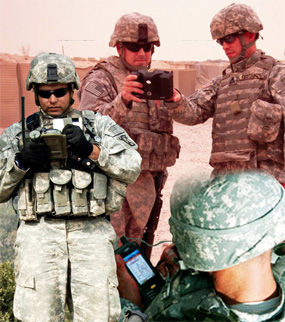Information, or ‘content’, on the World Wide Web is replicated and distributed across the world to ensure high availability to the end-user. User expectations for rapid access to content have led to the creation of content distribution systems that enhance the user experience. Consequently, users may quickly access content used for everyday living, from restaurant menus and maps, to local and world news.

Likewise, within the military domain, content is essential to operations. Modern warfare, as epitomized by our current ground operations, is conducted by small units at the tactical edge, and up-to-date information is critical to mission success. Battlefield content is generated and resident in many locations.
For example, information can be generated at the edge, such as images of local leaders or prominent landmarks, social network information, or biometrics of suspects. Other information, such as maps or overhead imagery, is generated at higher echelons.
Currently, warfighters at the edge must reach back to facilities at higher echelon levels to obtain battlefield content and lack the capability to directly share information with other warfighters or neighboring units. This access requirement is not optimized for efficiency or speed.
Different constraints and different network architectures between commercial and military content distribution require different solutions. The commercial sector exploits an expensive, slowly changing computing and communications infrastructure. In contrast, the military uses a dynamic computing and communications infrastructure largely due to its mobility requirements. Content is often transported via wireless networks (i.e. Mobile Ad Hoc Networks – MANETs) that exhibit rapidly changing link capacity and network topologies, which complicates the process of content distribution.
The flexibility the military architecture introduces, along with a high degree of content correlation for warfighters within a geographic area, enables a unique opportunity for a new approach to content distribution that largely eliminates the need for designated, specialized servers.
The Content-Based Mobile Edge Networking (CBMEN) program seeks to develop the network services and transport architectures to enable efficient, transparent distribution of content in mobile ad hoc network environments. It is envisioned that battlefield applications will use these CBMEN network services to efficiently distribute content.
The goal of the CBMEN program is to reduce latency and increase the effective throughput of content for warfighters at the tactical edge. The Content-Based Mobile Edge Networking (CBMEN) program has completed initial field testing of software for rapidly sharing up-to-date imagery, maps and other vital information directly among front-line units
Squads of Soldiers or Marines on patrol in remote forward locations often don’t have the luxury of quickly sharing current intelligence information and imagery on their mobile devices, because they can’t access a central server. Troops frequently have to wait until they’re back at camp to download the latest updates. In the meantime, mission opportunities may erode because the information needed at the tactical edge isn’t immediately available.
DARPA’s Content-Based Mobile Edge Networking (CBMEN) program aims to provide an alternative approach to the top down focus of most military networks, which provide content over a common operating environment from the strategic to tactical level. Unfortunately, the tactical level is still a severely constrained communications environment, and often when deployed, networks may not have connectivity to higher headquarters and servers needed to provide the latest updates from other units in the area.

CBMEN turns this world upside down and starts the content sharing at the individual Soldier or Marine level. If a set of radios or cell phones are disconnected from higher headquarters units, the individuals can still generate and share critical content on their own, significantly improving their common situational awareness and the ability to carry out their mission. This concept moves past the Internet’s “hub-and-spoke” paradigm of requiring point-to-point communications to first go through a central server.
DARPA successfully field-tested CBMEN software loaded on Android-based smartphones and Army Rifleman Radios recently at Fort A.P. Hill, Virginia, marking the completion of Phase 1 of the program.
“CBMEN may not sound revolutionary, because people take server access for granted when cell towers, fiber-optic connections and 4G/LTE networks are so widely available worldwide,” said Keith Gremban, DARPA program manager. “But when that infrastructure is not available, CBMEN technology enables real-time information sharing where it hasn’t been possible before. CBMEN puts secure, private collaboration and cloud storage in your pocket.”
The program aims to make each squad member’s mobile device function as a server, so content is generated, distributed and maintained at the tactical edge where it’s needed. As long as troops are within communication range—whether by radio, cellular, Wi-Fi or other radio frequency devices—CBMEN software automatically replicates and shares updates, causing the tactical cloud to grow and diminish as users move in and out of range of each other. Any connected collection of warfighters can store and share information in many places right at the tactical edge, making the system tolerant of communications disruptions. In essence, CBMEN creates secure frontline cloud storage services that provide content with decreased latency and increased availability.
The field tests proved the concept works and highlighted the potential benefits of real-time information sharing. At one point in the testing, two squads on foot patrol came within communication range of each other. One squad had information about a simulated person of interest that the other squad was seeking. The CBMEN software, working in the background on the troops’ mobile devices, automatically transferred the information from the first squad to the other, without the second squad having to ask for it. As the second squad entered a building where the person of interest was, the squad used that information to immediately identify and apprehend its target.
The testing also identified areas that need further development such as enhancing security and improving efficiency of information exchange, which will be the focus of the next phase of the program. The goal is to reduce the number of transmissions required, which would save power, and to also reduce the bandwidth needed.
A key factor that enables CBMEN is the tremendous computing power available in current mobile devices. “There’s more computing power and memory in my smartphone than the supercomputer I used in college,” Gremban said. “With 64 gigabytes of storage in a single smartphone, a squad of nine troops could have more than half a terabyte (500 GB) of cloud storage. CBMEN taps into that huge capacity.”
Beyond supporting troops on the frontlines, CBMEN technology may also be useful for civilian applications, especially disaster response, where the established communication infrastructure is unavailable or destroyed. Like forward-deployed troops with no established communications infrastructure, firefighters, police, medical personnel, National Guard members and others responding to a major disaster could quickly share imagery and vital information amongst each other.
Phase 2 of CBMEN program kicked off this month to mature the technology. The objective is to demonstrate improved warfighting mission support in a complex joint-content sharing environment between United States Marine Corps and Army networks using both military radios and commercial smartphone Wi-Fi capabilities.

“Content sharing, starting at the tactical edge, is changing the world in the way information can be shared for warfighters who need it most,” Gremban said.
Article and images are courtesy of DARPA Strategic Technology Office.DARPA Strategic Technology Office.
Program Manager: Dr. Keith Gremban, keith.gremban@darpa.mil

